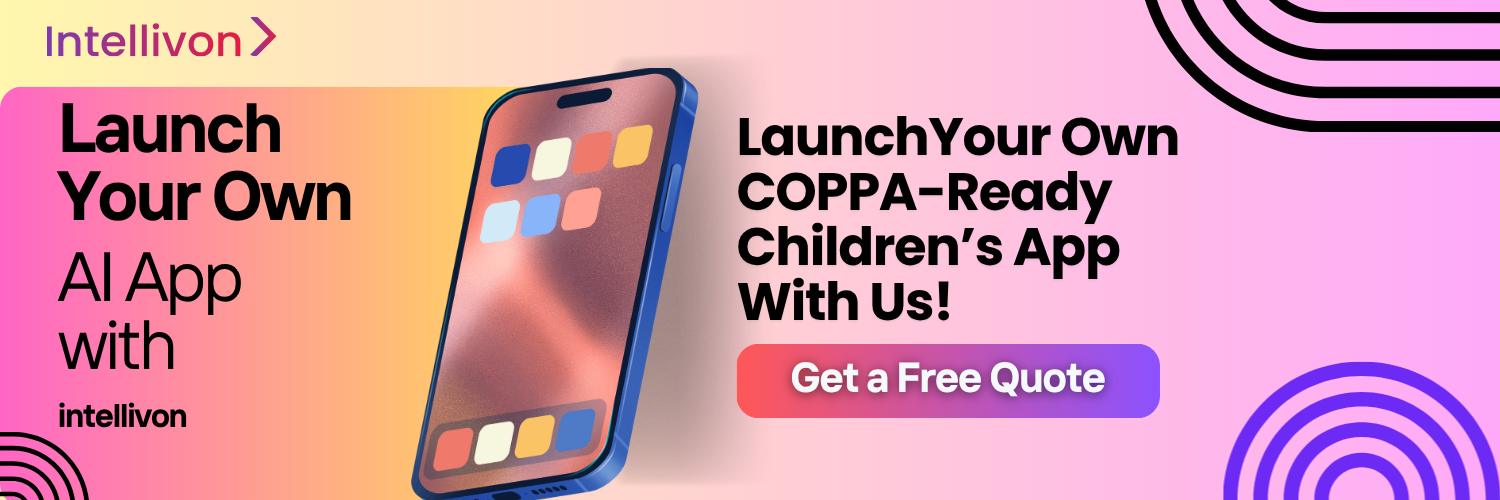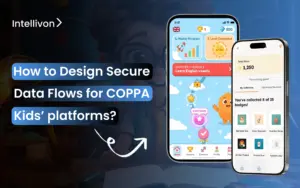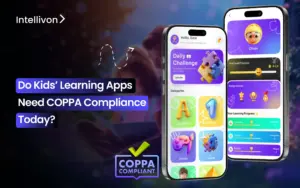Parents are concerned about what their children consume, how apps influence learning, and what data gets collected in the background. One breach or unclear data policy can lead them to abandon a platform. They prefer learning apps that protect their children from profiling, hidden trackers, and unnecessary data collection. This change has made COPPA-compliant kids’ apps the standard expectation rather than an optional feature.
At Intellivon, we create children’s platforms with privacy built in from the start, and not added in later. Our systems limit third-party exposure, prevent unsafe data flows, and reinforce every interaction with built-in safeguards that parents can trust.
Our experts also design the framework so breaches, misuse, and silent data sharing simply cannot happen. In this blog, we share our years of enterprise experience to explain how we build compliant, resilient, and COPPA-ready children’s learning apps from the ground up.
Key Takeaways of The Compliant Kids Apps Market
The global market for apps designed for children is expanding rapidly. It is expected to reach $2.2 billion by 2025 and surge to $16.18 billion by 2033, supported by a strong 28.4% CAGR. This trajectory reflects rising digital adoption in early education and growing parental demand for safer, more structured learning environments.
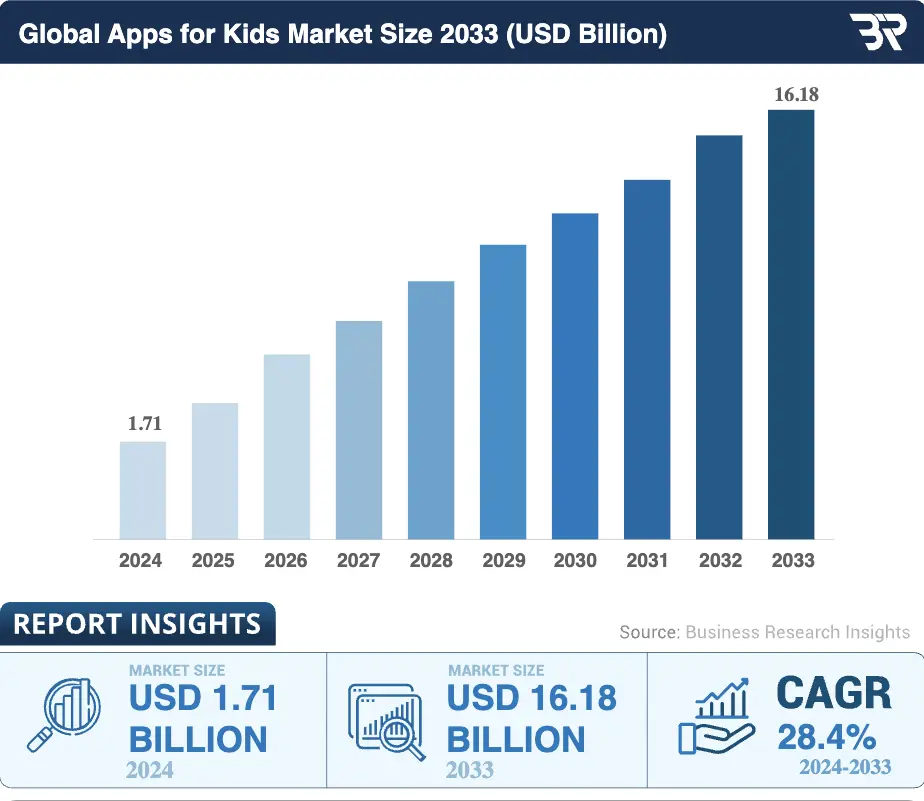
Market Insights
- Strict frameworks such as COPPA in the US and GDPR-K in Europe now shape how children’s edtech platforms handle data, obtain consent, and design parental controls.
- A 2023 FTC review reported that 56% of children’s apps failed to obtain verifiable parental consent, limiting market access for non-compliant platforms.
- The K–12 segment leads global compliance spending, accounting for more than 46% of total investment as schools prioritise privacy, accessibility, and online safety.
User and Institutional Adoption Trends
- Over 70% of K–5 teachers in the US used educational apps in classrooms during 2023, signaling strong institutional adoption.
- During the COVID-19 disruption, more than 1.3 billion children experienced school closures, accelerating long-term demand for safe, app-based learning tools for ages 4–14.
Notable Players in the Game
- UK: BBC Bitesize and Seneca Learning are widely used for revision, online lessons, and hybrid learning models across British schools.
- These platforms emphasise strong privacy controls and clear data-handling policies, which make them preferred choices for primary and secondary education.
- US: ABCmouse, Khan Academy Kids, Lingokids, and PBS Kids remain trusted for their privacy-focused architectures and high engagement rates among early learners.
Key Compliance and Market Statistics (UK & US)
- 42% of apps in Europe and the UK still use misleading design patterns, although regulatory pressure is driving significant improvements.
- COPPA violations in the US can lead to fines of up to $51,744 per child per violation, placing clear financial risk on non-compliant developers.
- Leading UK edtech platforms such as BBC Bitesize, Seesaw, and Seneca disclose privacy audits and data policies as part of their public positioning.
- Parents in the UK and US consistently list data privacy as a top-three selection factor, ranking it above content variety or app design.
Adoption Trends and Buyer Guidance
- Hybrid and remote learning have strengthened demand for privacy-ready platforms, especially for ages 4–11 in the UK and K–5 in the US.
- Successful market entrants need strong technical compliance and parent-facing transparency, including clear consent workflows and accessible reporting tools.
- Platforms prepared for COPPA and GDPR-K gain a strategic advantage, enabling smoother expansion across both the UK and US edtech markets.
The number of new entrants in the children’s edtech market shows how strongly demand is rising for safe, well-governed learning platforms. With privacy now shaping purchase decisions, the organisations that build COPPA-ready products stand to gain both trust and long-term growth.
What Is a COPPA-Safe Kids Learning App?
A COPPA-safe kids learning app is designed to protect the privacy of children under 13 while offering a secure, engaging learning experience. It collects only the information required to run the platform, gives parents full control over how data is used, and follows strict rules around consent, storage, and third-party access. These apps prioritise safety as much as content quality, which is why they are now the preferred choice for families, schools, and districts.
1. Built With Data Minimisation
A COPPA-safe app only uses the data it truly needs. It avoids sensitive information, unnecessary identifiers, and hidden analytics.
This reduces exposure and limits the number of systems that ever touch a child’s data. For enterprise teams, this approach simplifies compliance and strengthens user trust from the first interaction.
2. Designed Around Verified Parental Consent
Parents must approve any data collection before a child can use the app. Verified consent methods, such as email confirmation, ID checks, or school-authorised approval, ensure that no personal information flows without a parent’s involvement.
This creates a transparent relationship between the platform and the families who rely on it.
3. Accessible Parental Controls
Families expect visibility and control. A COPPA-safe app gives parents access to dashboards where they can manage permissions, review data, update settings, and request deletion.
These controls help parents feel confident that the learning experience is safe and accountable.
4. No Behavioural Tracking
COPPA-safe platforms do not use profiling, behavioural ads, or cross-app identifiers. They avoid advertising networks that track users across devices and services.
This limitation is essential for creating a secure environment that keeps learning free from hidden commercial influence.
5. Engineered to Restrict Third-Party Access
A compliant app limits how many vendors interact with its data. Every SDK, plugin, or analytics tool must meet strict safety and handling standards.
This reduces the risk of external misuse and strengthens the overall security posture of the platform.
6. Secure by Design Across the Entire Data Flow
The architecture uses encrypted storage, protected APIs, and strong access governance. Data only moves between authorised components, and retention rules follow strict timelines. This ensures that information is stored safely and discarded responsibly.
A COPPA-safe kids learning app creates a protected space where children can learn without unnecessary data exposure. For enterprises, building this foundation early leads to stronger trust, smoother adoption, and long-term market credibility.
What Types of Data Are Legally Allowed Under COPPA Guidelines?
COPPA allows children’s learning apps to collect only the information needed to run core features and support the learning experience. Every data point must serve a clear purpose, follow strict consent rules, and avoid creating profiles or behavioural records. For enterprises, this means designing data flows that collect less, store less, and expose less.
1. Basic Account Information
A COPPA-safe platform can collect limited account details, but only after a parent verifies permission. This usually includes a username, parent email, and child age range. The goal is to support login and personalise content without relying on sensitive identifiers. It keeps the learning experience functional while protecting the child’s identity.
2. Learning Progress and In-App Activity
Behavioural tracking is restricted, but apps may collect progress data to support lessons, rewards, and personalised tasks.
These data points include completed levels, quiz scores, reading history, and time spent on specific activities. They must never be shared with advertisers or blended with external datasets.
3. Device and Operational Data
COPPA permits collecting technical information required to keep the app running safely. This can include device type, app version, crash logs, and connection status. The data supports troubleshooting and performance improvement, but it cannot be used to identify a child or track them across services.
4. Parent-Initiated Communication
If parents contact customer support, the platform may collect the information required to resolve the issue. This often includes messages, screenshots, or email threads. The communication must stay within the support workflow and cannot be repurposed for marketing or profiling.
5. Data That Avoids Sensitive Identifiers
COPPA prohibits collecting or storing data such as GPS location, photos, audio recordings, or precise identifiers unless a parent explicitly approves it and the feature requires it. Most compliant learning apps avoid these fields entirely. This reduces exposure and keeps the platform safe at scale.
COPPA only permits data that serves a clear learning or operational purpose. For enterprises, keeping data lean and transparent builds trust with families and educators who now expect privacy to be built into every children’s platform by default.
How a COPPA-Safe Kids’ Learning App Works?
A COPPA-safe kids’ learning app is more than a learning tool with a privacy policy. It is a controlled environment where every data flow, feature, and integration follows a strict compliance workflow. The steps below show how such a platform operates from first launch to ongoing monitoring.
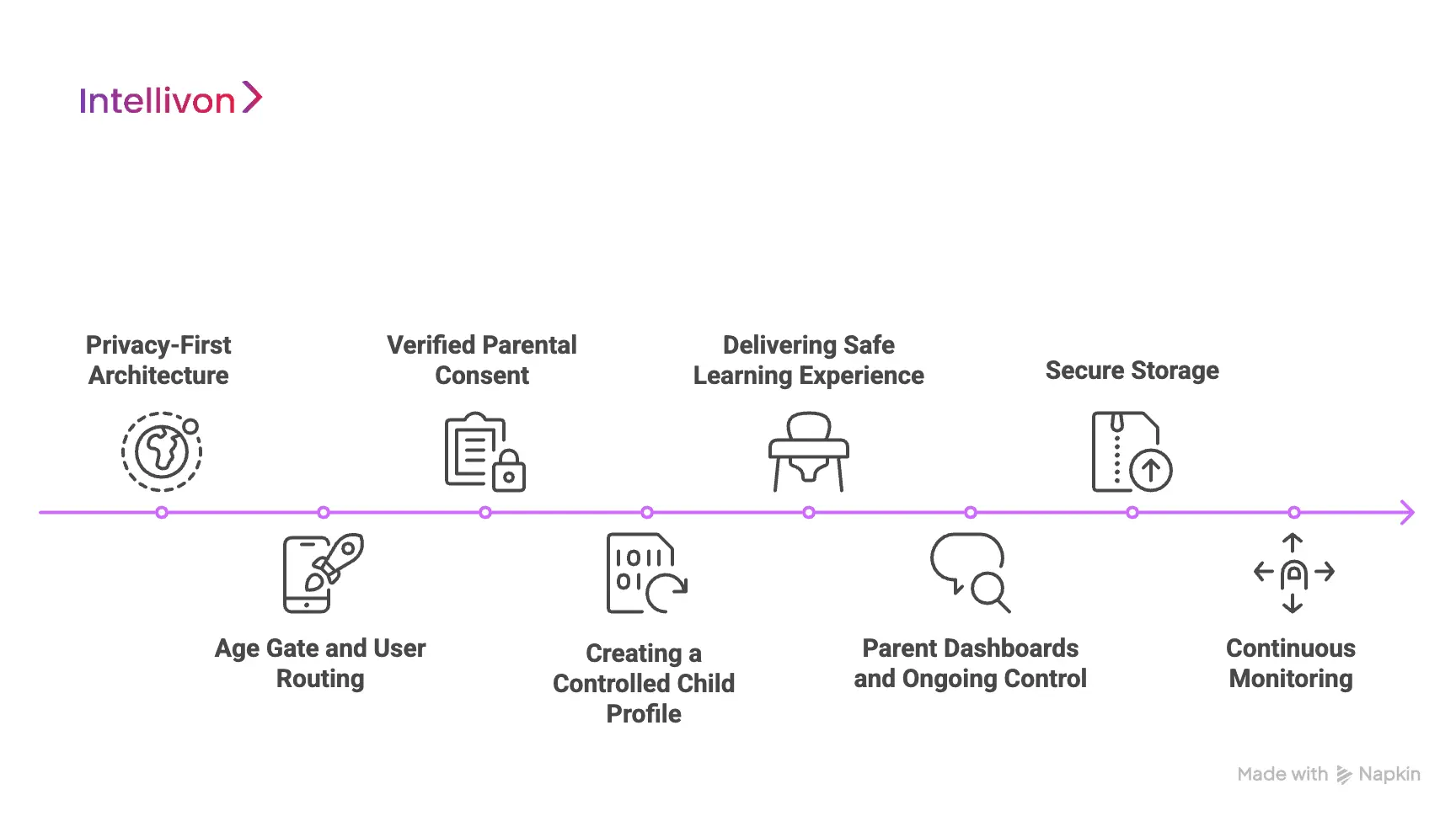
Step 1: Privacy-First Architecture
The work begins before development. Product, legal, and engineering teams define what data the app needs and what it will avoid. They map data flows, storage locations, vendors, and access rules. This ensures the platform collects only what supports learning.
Teams at this stage:
- List every feature and the minimum data required for it
- Decide which events to track and which to block
- Separate child data from marketing or generic analytics systems
- Define retention, deletion, and parental access policies
This foundation makes compliance part of the architecture rather than a late patch.
Step 2: Age Gate and User Routing
The first screen identifies who is using the app. A neutral age gate asks for the user’s age without nudging them. The system uses this information only for routing.
If the user is under 13, the app:
- Pauses personal data collection
- Redirects to a parent or guardian onboarding screen
- Explains why consent is required in simple language
A different onboarding path applies if the user is older.
Step 3: Verified Parental Consent
Before a child profile becomes active, the platform must capture verifiable parental consent. This step controls every sensitive feature. The app clearly explains what data will be collected and how parents can manage it.
Common methods include:
- Email-plus verification
- Payment method checks are used only for identity verification
- School or district-issued approval for classroom use
Only after consent can the app store account details, learning progress, or any persistent child data.
Step 4: Creating a Controlled Child Profile
After consent, the system creates a profile with only essential details. This may include a username, age band, and basic learning preferences. It avoids full names, precise location, and unnecessary identifiers.
At this stage, the platform:
- Links the child profile to a parent or school account
- Applies access rules and content filters
- Activates logging for security and audits without over-collecting data
This controlled profile anchors learning progress safely.
Step 5: Delivering A Safe Learning Experience
The learning experience runs in a sandbox. All content and interactions work without behavioural tracking or targeted ads. The focus stays on skills, progress, and engagement.
During use, the system can:
- Track lesson completion and scores
- Recommend activities based on performance
- Store data needed for learning continuity
Analytics remain aggregated or de-identified where possible.
Step 6: Parent Dashboards and Ongoing Control
Parents need more than a one-time consent prompt. A COPPA-safe app includes a dashboard where parents can review information and adjust controls.
From this dashboard, they can:
- View stored data and its purpose
- Disable features or data uses
- Download or delete their child’s data
This shows respect for families as active data owners.
Step 7: Secure Storage
The backend applies strict governance. Data is encrypted in transit and at rest. Access is limited to authorised services and tracked through role-based controls.
The organisation also:
- Audits each SDK and external service
- Blocks vendors that cannot meet safety standards
- Applies retention timers so data is deleted when no longer needed
This extends compliance across the entire stack.
Step 8: Continuous Monitoring
Regulations and product features evolve. A COPPA-safe platform requires ongoing reviews rather than one-time certification.
These reviews include:
- Privacy and security checks after major releases
- Updates to consent language when features change
- Routine evaluation of vendor behaviour and SDK updates
This keeps compliance aligned with real-world risks.
A COPPA-safe kids’ learning app works through a disciplined, step-by-step workflow. Each stage protects children, empowers parents, and limits third-party exposure.
Why Over 80% of Parents Back Compliant Kids’ Platforms
Parents have become far more alert to how digital products treat their children’s information. Their expectations now shape which platforms earn trust and which ones never make it past the first evaluation. For enterprises building learning apps for young users, this shift turns compliance into a strategic advantage rather than a regulatory checkbox.
1. Parental Concern at an All-Time High
Research from the UK’s Information Commissioner’s Office shows that 9 in 10 parents worry about how companies handle their child’s data. That level of concern creates a credibility gap for any product that cannot clearly explain its safeguards. Organisations entering this segment need visible, consistent reassurance from the first interaction.
2. Trust Drives Adoption
Parents influence educators, district leaders, and procurement teams more than most platforms realise. When a product signals a strong child-privacy posture, it moves through selection stages faster.
This matters because over 80% of parents believe child-specific privacy rules improve online safety. It sets an expectation that learning tools built for children must meet higher safety standards to earn adoption.
3. Data Misuse as a Competitive Liability
A detailed study of children’s apps found a persistent pattern of non-compliance. Researchers reported that 81.25% of child-oriented apps still used tracking SDKs, even though those categories were meant to be more restricted.
This gap between stated policy and actual practice creates visible risk for any enterprise entering the market. It also sends a clear message: platforms must be able to show how they limit unnecessary data flows, not only claim to do so.
4. Legislation Reshaping Market Opportunity
Regulators have intensified their oversight. The ICO recently issued information notices to companies that failed to meet its standards. This reflects a broader shift from guidance to direct intervention.
For enterprises, this means privacy design now influences bids, partnerships, and school licensing decisions.
5. Parental Expectations Shaping Monetisation
Parents pay close attention to how learning apps generate revenue. Behavioural advertising, cross-profile targeting, and identifiers tied to third-party networks often fail their safety test.
They prefer platforms that minimise data use and rely on transparent business models. This expectation affects decisions about analytics, ad technologies, and external SDKs across an enterprise technology stack.
Takeaway
Parental concern has reached a level that organisations can no longer ignore. Combined with stronger regulatory action and rising demand for safer digital ecosystems, COPPA-aligned infrastructure has become a core requirement in children’s app development.
Enterprises that build privacy into their design, governance, and data flows earn faster adoption, deeper trust, and long-term strategic advantage in a rapidly expanding market.
Core Features Every COPPA-Ready Children’s App Must Have
A COPPA-ready children’s app is defined less by marketing and more by its internal safeguards. Every feature that touches a child’s data must be intentional, limited, and accountable. The ten features below form a practical checklist for any enterprise planning to launch or scale kids’ learning platforms.
1. Verified Parental Consent
A robust consent flow is essential. The app must pause personal data collection until a parent completes the process. Consent screens explain what is collected, why it matters, and how parents can change it later. This turns consent into a transparent agreement.
2. Neutral Age-Gating
A COPPA-ready app uses a neutral age gate that avoids nudging children. The system uses the age response only for routing. Under-13 users enter a parent-led onboarding flow, while older users follow a separate path. This early routing prevents accidental non-compliance.
3. Purpose-Limited Collection
The platform collects only the data needed for learning and security. It avoids unnecessary identifiers and open-ended text fields. Every field must support a clear use case, such as login or progress tracking. This keeps exposure low and simplifies compliance checks.
4. Parent Dashboard
A COPPA-ready app provides a dashboard with meaningful parental controls. Parents can see what data exists and why it is stored. They can update permissions, change settings, and request deletion or export. This level of transparency builds long-term trust.
5. No Behavioural Ads
Children’s apps should not serve behavioural ads or track activity across services. COPPA-ready platforms avoid networks that build profiles from child behaviour. Any monetisation must work without personal targeting. This protects children from hidden commercial influence.
6. Strong Encryption
Security controls support every compliance effort. A compliant app encrypts data in transit and at rest. APIs, databases, and storage follow strict access rules. Logging and alerts help teams react quickly to potential threats. These measures reduce the impact of incidents.
7. Strict Governance
Most compliance failures begin with unmanaged vendors. A COPPA-ready app audits every SDK and analytics library before adoption. Vendors must prove they handle child data safely. If they cannot meet that standard, they are removed from the stack.
8. Role-Based Access Control
Inside the organisation, access to child-level data must be limited. Role-based permissions ensure only authorised staff can view sensitive information. Audit logs track who accessed what and when. These logs support investigations, audits, and internal reviews.
9. Clear, Human-Readable Privacy
Privacy notices must be easy for families and schools to understand. They use simple language and specific examples of data use. In-app prompts reinforce these messages during sign-up or feature updates. This clarity reduces confusion and complaints.
10. Automated Retention
Data cannot stay in the system indefinitely. A COPPA-ready app enforces strict retention rules. When data is no longer needed, automated processes delete it from active systems. This keeps databases lean and reduces long-term risk.
These ten features form the foundation of a serious COPPA-ready kids’ app strategy. For enterprises, doing this well turns safety into a clear competitive advantage.
Additional COPPA-Readiness Features That Strengthen Compliance
Beyond core safeguards, mature platforms add deeper layers of protection that create long-term trust and resilience. These features help apps stand out in markets where parents, schools, and regulators expect higher privacy standards.
1. Context-Aware Privacy Controls
A strong COPPA-ready platform updates privacy settings as children grow older. Younger users see stricter defaults, while older learners receive slightly more flexibility.
BBC Bitesize and Khan Academy Kids follow this pattern by offering age-banded experiences with different content types and permissions. This keeps the learning journey safe and suitable for each stage.
2. Built-In Content Filters
Filters prevent children from accessing inappropriate content, even if the app allows some external links. Many US-based platforms, such as PBS Kids, use controlled environments where every video, game, and activity passes content checks.
In the UK, BBC Bitesize applies editorial vetting to ensure lessons remain age-appropriate and curriculum-aligned. This filtering reduces the risk of accidental exposure.
3. Offline Learning Modes
A compliant app offers offline access without quietly storing extra personal information. This protects children who use devices without constant supervision.
Lingokids and Khan Academy Kids provide offline lessons where only progress data is stored locally and synced later with parental knowledge. This supports safe learning during travel or limited connectivity.
4. Transparent Reporting Tools
Parents and teachers prefer platforms that explain learning progress clearly without exposing personal data. A COPPA-ready app includes dashboards, progress reports, and usage summaries that avoid unnecessary detail.
Seesaw, widely adopted in UK and US classrooms, gives teachers controlled reporting tools that separate child identifiers from shared work. This keeps communication safe and compliant.
5. AI-Assisted Safety Monitoring
Some platforms use AI to support moderation or improve learning, but compliant systems do so without building behavioural profiles.
For example, Seneca Learning in the UK uses AI to personalise revision paths without collecting sensitive data or tracking across services. The AI stays within strict boundaries, ensuring safety and fairness.
6. Regional Compliance Layering
Apps operating in both the US and UK must balance COPPA and GDPR-K requirements. A strong system builds region-aware flows that adjust consent, notices, and parental rights automatically.
Platforms like ABCmouse and BBC Bitesize run in multiple regions with distinct privacy configurations. This ensures each user receives protections aligned to their local regulations.
These additional features strengthen a platform’s compliance posture and create a safer experience for children, families, and schools. When combined with core COPPA requirements, they help learning apps build trust quickly and maintain it as they scale across markets.
How We Build COPPA-Ready Children’s Apps
At Intellivon, a COPPA-ready kids’ learning app is designed like a secure enterprise system. Every workflow, consent point, and data path is planned before a single line of code is written. This step-by-step approach helps us build platforms that parents trust, schools approve, and regulators can verify with confidence.
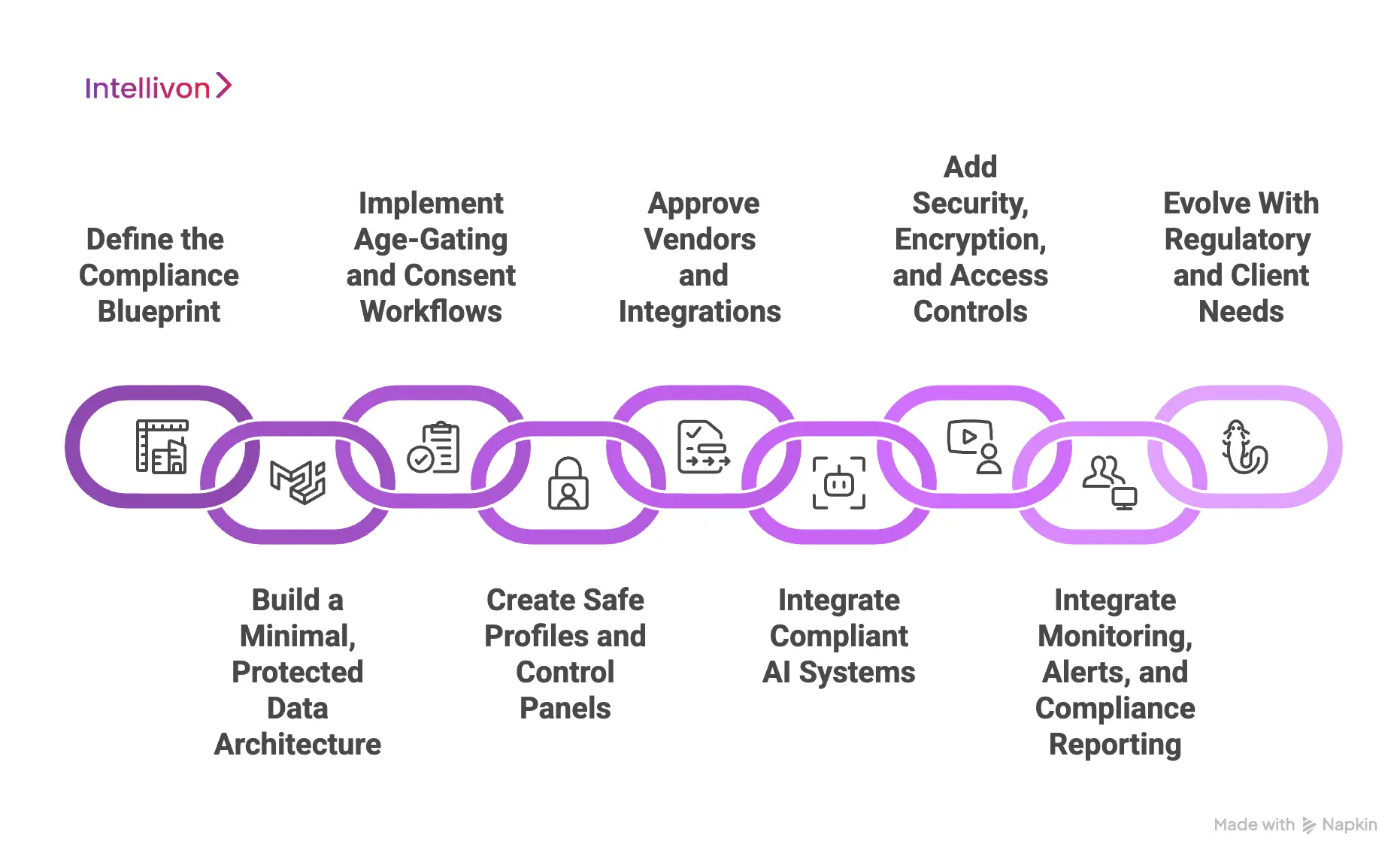
1. Define the Compliance Blueprint
We begin with a structured discovery phase. Product, legal, data, and security teams work together to outline what the app must do, what data it needs, and what must never be collected. We map consent events, parental controls, and vendor interactions. This blueprint becomes the foundation for design, engineering, and future audits.
2. Build a Minimal, Protected Data Architecture
With the blueprint in place, we design the architecture around minimal data collection. Child data is isolated from marketing systems, open analytics tools, and unnecessary storage layers. We keep only what supports learning or platform safety. This reduces both exposure and compliance overhead for the enterprise.
3. Implement Age-Gating and Consent Workflows
Age verification is embedded into the app’s first interaction. If the user is under 13, the system pauses all personal data collection and shifts into a parent-led onboarding flow. Verified parental consent is then captured through approved methods. Every step is logged to support compliance reviews or school audits.
4. Create Safe Profiles and Control Panels
Once consent is confirmed, we generate a child profile with only essential information. No full names, precise locations, or unnecessary identifiers flow into the system. We pair this with parent and school dashboards that show stored data, permissions, and access options. Users can update, download, or delete information whenever they choose.
5. Approve Vendors and Integrations
Every SDK, analytics tool, payment gateway, or cloud service undergoes a detailed evaluation. We analyse what data each partner touches, how they store it, and whether they reuse it. Vendors that do not meet COPPA or GDPR-K expectations are removed. This governance layer ensures the app cannot leak data through hidden integrations.
6. Integrate Compliant AI Systems
AI can support learning, moderation, and engagement, but it must operate in a tightly controlled environment. We design AI features that work on limited, purpose-specific data and avoid behavioural profiling. Models run on de-identified inputs, and outputs stay inside the platform with no third-party reuse.
We also build filters and guardrails that detect unsafe content, minimise bias, and keep interactions age-appropriate. This approach lets enterprises offer intelligent learning features without breaking trust or crossing regulatory lines.
6. Add Security, Encryption, and Access Controls
We secure the platform with encryption, role-based access, and tracked permissions. Sensitive actions generate audit logs, allowing teams to understand who accessed what and when. This provides visibility during incidents and helps organisations prove compliance during external reviews.
7. Integrate Monitoring, Alerts, and Compliance Reporting
After deployment, our monitoring system tracks unusual activity, consent failures, and third-party behaviour. Alerts notify the right teams when something needs attention. We also generate compliance documentation and reports for districts, regulators, and partner institutions.
8. Evolve With Regulatory and Client Needs
COPPA, GDPR-K, and related children’s privacy guidelines continue to evolve. We update consent language, flows, and notices whenever regulations shift or new features are introduced. This keeps the app aligned with requirements across the US, UK, and Europe without disrupting the product roadmap.
This step-by-step process ensures every Intellivon-built children’s app is COPPA-ready from the start, not retrofitted at the end. Enterprises gain a platform built on trust, reinforced by strong governance and designed for long-term growth in regulated markets.
Cost to Build COPPA-Ready Children’s Apps
At Intellivon, we help enterprises build COPPA-ready kids’ learning platforms that are trusted by families, schools, and regulators. Costs vary based on scope, regulatory depth, market region (US, UK, or EU), and the level of privacy controls required. Our priority is to help clients launch platforms that protect children, minimise risk, and meet long-term compliance expectations.
When budgets are tight, we work with product, legal, and IT leaders to refine scope without compromising COPPA, GDPR-K, or Age-Appropriate Design Code alignment. Every build is planned for long-term stability, transparent data flows, and regulatory readiness. The goal is to create a platform that parents trust and institutions can adopt without hesitation.
Estimated Phase-Wise Cost Breakdown
| Phase | Description | Estimated Cost Range (USD) |
| Discovery & Compliance Alignment | Requirements mapping, risk analysis, COPPA/GDPR-K scoping, data minimisation rules, consent workflow planning | $5,000 – $10,000 |
| Privacy-First Architecture Design | Data isolation design, encryption planning, role-based access layers, and regional compliance flows | $7,000 – $14,000 |
| Age Gate & Consent Engineering | Neutral age-gating, parent onboarding, verified consent systems, audit logging | $6,000 – $12,000 |
| Learning Module & Content Engine | Progress tracking, safe personalisation, offline learning, content filters, child-friendly UI | $10,000 – $20,000 |
| Parent Dashboard & Controls | Permission management, data view/download/delete tools, alerts, and reporting access | $6,000 – $12,000 |
| Vendor & SDK Governance Setup | Third-party audits, safe analytics, secure SDK selection, and integration hardening | $5,000 – $10,000 |
| Security & Compliance Engineering | Encryption, tokenisation, access controls, audit logs, continuous monitoring | $8,000 – $15,000 |
| Platform UX & Interfaces | Child experience, parent dashboard UI, school admin tools, accessibility design | $8,000 – $16,000 |
| Testing & Validation | COPPA testing, GDPR-K checks, penetration tests, and content safety validation | $5,000 – $10,000 |
| Pilot & Rollout | Limited launch, feedback cycles, refinement of controls, support setup | $5,000 – $10,000 |
| Deployment & Scaling | Cloud deployment, regional routing, failover design, and observability | $6,000 – $12,000 |
Total Initial Investment Range:
$50,000 – $140,000
Ongoing Maintenance & Optimization (Annual):
15–20% of the initial build
Hidden Costs Enterprises Should Plan For
- Integration complexity: Schools and districts may use mixed systems requiring custom connectors.
- Compliance overhead: Documentation, audits, and periodic assessments create recurring effort.
- Data governance: Normalising formats and maintaining separation across regions needs steady work.
- Cloud usage: Learning content, analytics, and secure storage require active cost management.
- Change management: Training teachers, parents, and admins introduces measurable transition costs.
- AI safety tuning: If AI is used, guardrails and bias checks require periodic recalibration.
Best Practices to Avoid Budget Overruns
- Start lean: Launch with core features, validate demand, then scale modules.
- Embed compliance early: Avoid rebuilding flows later, which drives cost.
- Use modular design: Reuse content engines, dashboards, and consent systems across regions.
- Optimise cloud spending: Mix real-time and batch processing where possible.
- Enforce observability: Track uptime, data flows, and vendor behaviour continuously.
- Iterate for longevity: Update privacy notices, refine controls, and test new regulations.
Request a tailored proposal from Intellivon’s edtech compliance experts. We will align your COPPA-ready roadmap with your budget, regulatory obligations, and long-term growth strategy.
Examples of Popular COPPA-Ready Kids’ Apps
Several COPPA-ready kids’ learning platforms have earned strong trust from families and schools by combining engaging learning experiences with strict privacy safeguards. Below are five leading apps that demonstrate what a well-designed COPPA-ready children’s platform looks like in real use.
1. Khan Academy Kids
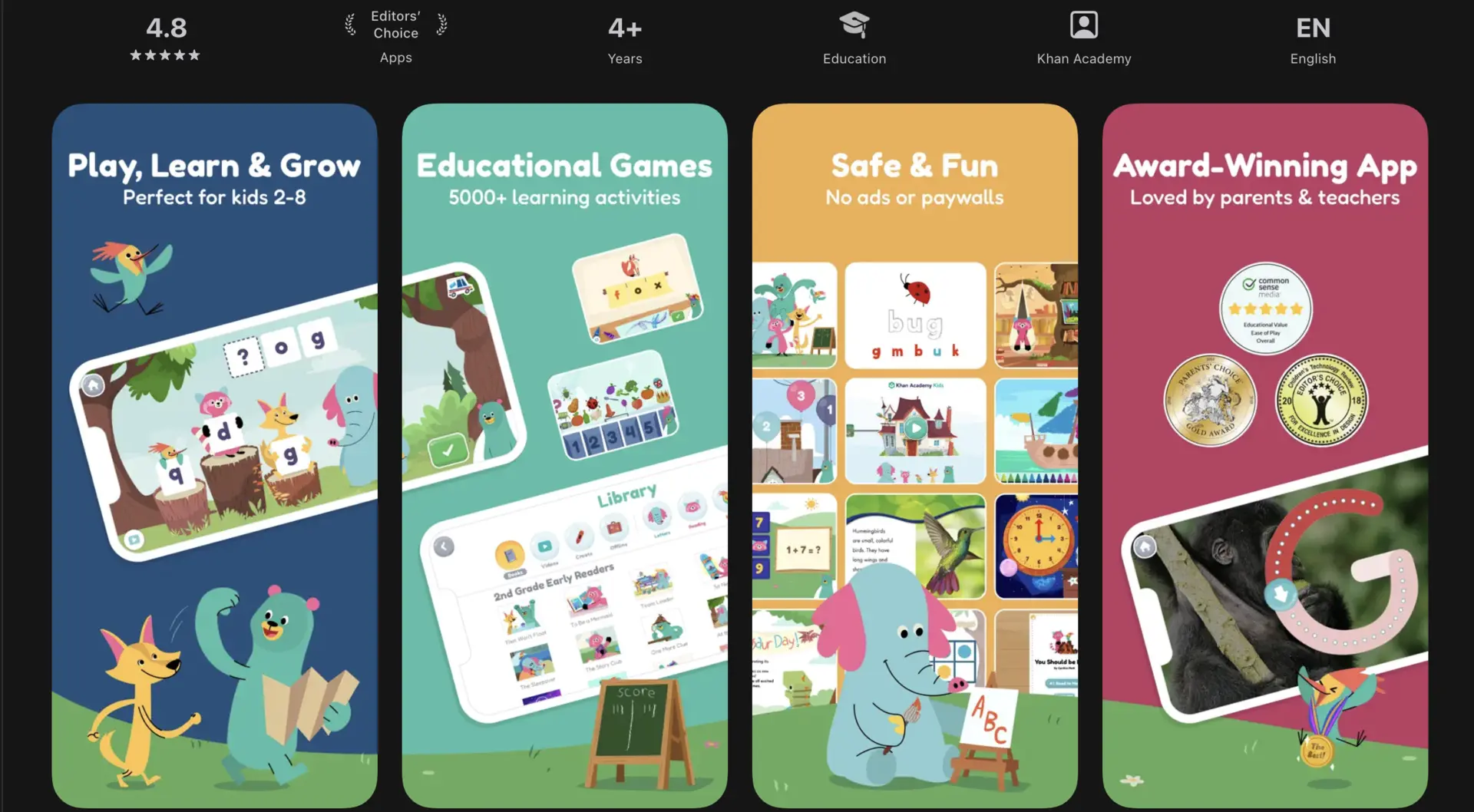
Khan Academy Kids remains one of the most popular learning apps for early learners. It focuses on reading, numeracy, creativity, and social-emotional skills. Parents trust the platform because it avoids behavioural tracking and uses a clear consent flow. The app has been downloaded over 43 million times.
Key Features:
- Age-appropriate lessons and skills-based activities
- Offline mode for safe, flexible use
- No ads or external trackers
- Parental controls and clear permissions
2. PBS Kids Games

PBS Kids Games offers a curated environment built around trusted educational media. Every activity goes through strict editorial review. Parents appreciate its simple privacy practices and ad-free learning model. The usage of the app is consistently high, with over 40 million games played each month.
Key Features:
- Curriculum-aligned games for early learners
- Fully controlled in-app environment
- No behavioural advertising
- Clear, human-readable privacy notices
3. BBC Bitesize
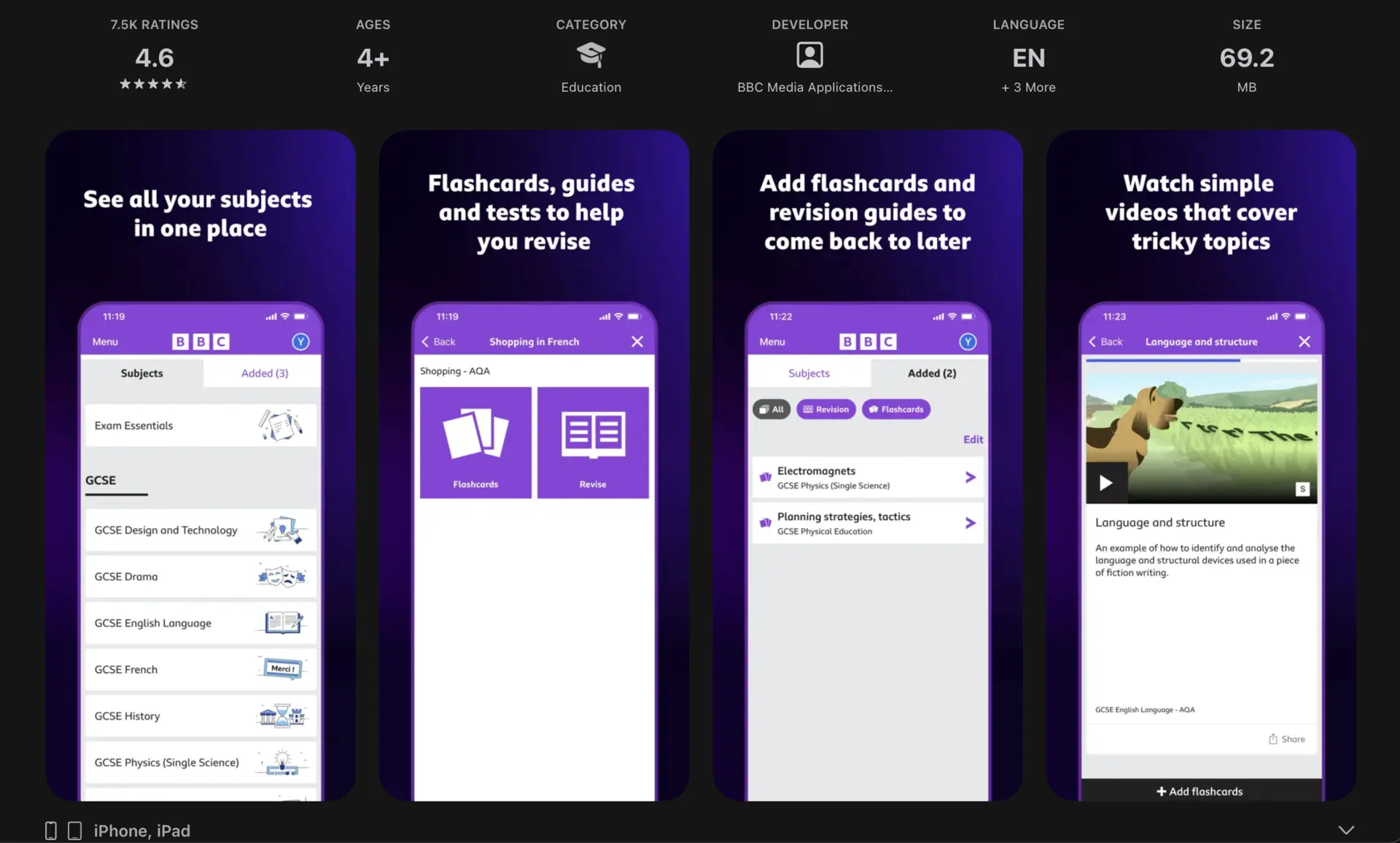
BBC Bitesize is a curriculum-aligned learning platform used across UK primary and secondary schools. It maintains strong compliance with the UK’s Age-Appropriate Design Code and provides transparent privacy reporting.
A recent campaign reached 90% of UK teens aged 15–17, demonstrating strong adoption among older learners.
Key Features:
- Curriculum-linked lessons and revision modules
- Editorial quality and content vetting
- No profiling or targeted advertising
- Clear and accessible data practices
4. Seneca Learning
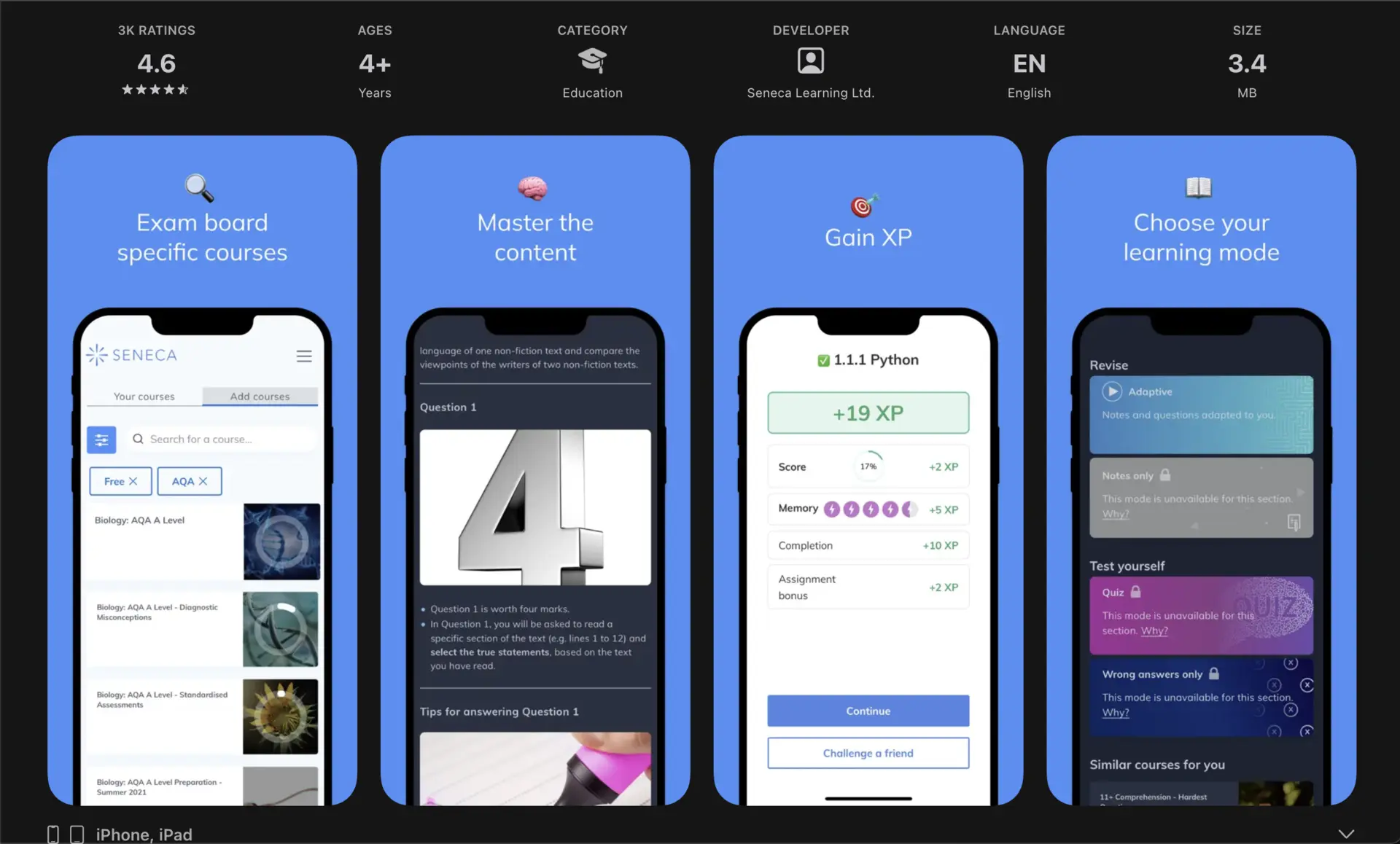
Seneca Learning provides AI-assisted revision tools without collecting unnecessary identifiers. Its design keeps personal data separated from analytics while offering strong learning outcomes. The platform is widely used, with over 5.5 million UK students learning on Seneca
Key Features:
- AI-powered revision aligned with UK curricula
- GDPR-K compliant design
- Strict limits on third-party integrations
- Easy adoption for schools and families
5. ABCmouse

ABCmouse provides a structured early-learning curriculum across reading, math, science, and creative skills. The platform is COPPA-certified and follows clear data minimisation rules. It maintains strong parental engagement, supported by over 3.3 billion YouTube video views on its educational content.
Key Features:
- Step-by-step learning path
- Safe in-app environment with no cross-app tracking
- Parent dashboard with progress insights
- Clear consent flows and data controls
These five apps show how strong privacy controls and thoughtful learning design can work together. They illustrate what families expect from modern children’s platforms and highlight the benchmarks enterprises must meet when building COPPA-ready kids’ apps that earn trust at scale.
Conclusion
The demand for safe, transparent, and well-governed children’s learning platforms has never been higher. Parents expect accountability, schools require proof of compliance, and regulators are tightening their oversight every year. In this environment, a COPPA-ready design is the foundation of long-term adoption and market credibility.
Enterprises that invest early in privacy-first architecture, controlled data flows, and responsible AI gain a measurable advantage. They build trust faster, scale across regions with fewer barriers, and avoid costly redesigns later. As the children’s app market grows, the winners will be the platforms that treat privacy as a strategy, not scaffolding. COPPA readiness is how you build a product that families can rely on for years.
Build a COPPA-Ready Children’s Platform With Intellivon
At Intellivon, we design COPPA-ready learning platforms built for privacy, safety, and large-scale adoption. Every layer, from architecture to consent flows, is engineered for strict compliance across the US, UK, and EU. This creates a platform that families trust, schools approve, and enterprises can deploy confidently across regions.
Our systems minimise data exposure, simplify regulatory reviews, and integrate smoothly with existing district tools. You get a single, secure platform designed for long-term growth and reliable learning outcomes, without compromising safety or transparency.
Why Partner With Intellivon
- Compliance-First Architecture: We design every build around COPPA, GDPR-K, and AADC. Safe defaults, minimal data, and strict isolation come standard.
- Verified Consent and Age-Gating: Neutral age gates and verifiable parental consent are built into the core workflow and are audit-ready.
- Responsible AI and Personalisation:
AI features use limited, de-identified inputs. No profiling, tracking, or hidden data sharing. - Secure Enterprise Infrastructure: Encryption, access governance, and audit logs ensure strong protection at all stages.
- Strict Vendor and SDK Governance: We review every third party to prevent leakage, resale, or unauthorised use of child data.
- Parent and School Controls: Dashboards allow parents and administrators to manage permissions, view data, and request deletion easily.
- Proven Edtech Delivery Experience: We bring multi-domain compliance and enterprise engineering experience to every engagement.
Connect with our team to explore how a COPPA-ready platform can strengthen trust, accelerate adoption, and reduce compliance risk across your markets.
FAQs
Q1. What is the minimum data my app can collect and still function under COPPA?
A1. A COPPA-ready app should only collect the information needed to create a basic account, run core learning features, and maintain platform security. This usually means a username, a parent email, and limited progress data. If you want anything beyond that, you must prove why it’s necessary and get clear parental consent. The less you collect, the stronger your compliance posture.
Q2. Do enterprise apps need parental consent even if schools use the platform?
A2. School-based consent is allowed, but only for tools used strictly for education. If your app sends data to external vendors, personalizes beyond curriculum needs, or uses analytics that fall outside “educational purpose,” parental consent becomes mandatory. Most enterprise platforms blend learning, engagement, and analytics—so in practice, verified parental consent is still required.
Q3. How can my engineering team prove COPPA compliance during an audit?
A3. Auditors expect documented evidence, not assurances. Your team should maintain detailed consent logs, data flow diagrams, vendor assessments, SDK audit reports, and access logs. Retention rules, deletion workflows, and change history should also be recorded. When everything is traceable, audits become faster and far less disruptive.
Q4. Which analytics tools are considered COPPA-safe for enterprise apps?
A4. Choose analytics tools that avoid behavioural tracking, do not build profiles, and process all events in an anonymized format. Many mainstream SDKs collect device IDs or usage fingerprints, which can violate COPPA by default. Education-focused analytics, privacy-preserving event trackers, or custom in-house dashboards are the safest choices for large-scale deployments.
Q5. How do we handle third-party SDKs without risking a COPPA violation?
A5. Treat every SDK as a potential data leak until it’s proven safe. Disable advertising IDs, turn off behavioural tracking parameters, and ensure the SDK doesn’t send information to outside servers. Require data-processing agreements that define how child data can and cannot be used. If an SDK cannot meet these requirements, it should not be in your app.



